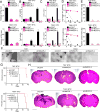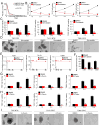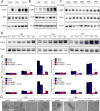MYC-Regulated Mevalonate Metabolism Maintains Brain Tumor-Initiating Cells
- PMID: 28729418
- PMCID: PMC5600855
- DOI: 10.1158/0008-5472.CAN-17-0114
MYC-Regulated Mevalonate Metabolism Maintains Brain Tumor-Initiating Cells
Abstract
Metabolic dysregulation drives tumor initiation in a subset of glioblastomas harboring isocitrate dehydrogenase (IDH) mutations, but metabolic alterations in glioblastomas with wild-type IDH are poorly understood. MYC promotes metabolic reprogramming in cancer, but targeting MYC has proven notoriously challenging. Here, we link metabolic dysregulation in patient-derived brain tumor-initiating cells (BTIC) to a nexus between MYC and mevalonate signaling, which can be inhibited by statin or 6-fluoromevalonate treatment. BTICs preferentially express mevalonate pathway enzymes, which we find regulated by novel MYC-binding sites, validating an additional transcriptional activation role of MYC in cancer metabolism. Targeting mevalonate activity attenuated RAS-ERK-dependent BTIC growth and self-renewal. In turn, mevalonate created a positive feed-forward loop to activate MYC signaling via induction of miR-33b. Collectively, our results argue that MYC mediates its oncogenic effects in part by altering mevalonate metabolism in glioma cells, suggesting a therapeutic strategy in this setting. Cancer Res; 77(18); 4947-60. ©2017 AACR.
©2017 American Association for Cancer Research.
Conflict of interest statement
Conflict of interest statement: The authors declare no potential conflicts of interest.
Figures







References
-
- Stupp R, Hegi ME, Mason WP, van den Bent MJ, Taphoorn MJ, Janzer RC, et al. Effects of radiotherapy with concomitant and adjuvant temozolomide versus radiotherapy alone on survival in glioblastoma in a randomised phase III study: 5-year analysis of the EORTC-NCIC trial. Lancet Oncol. 2009;10:459–66. - PubMed
-
- Bao S, Wu Q, Sathornsumetee S, Hao Y, Li Z, Hjelmeland AB, et al. Stem cell-like glioma cells promote tumor angiogenesis through vascular endothelial growth factor. Cancer Res. 2006;66:7843–8. - PubMed
-
- Bao S, Wu Q, McLendon RE, Hao Y, Shi Q, Hjelmeland AB, et al. Glioma stem cells promote radioresistance by preferential activation of the DNA damage response. Nature. 2006;444:756–60. - PubMed
MeSH terms
Substances
Grants and funding
- R01 NS091080/NS/NINDS NIH HHS/United States
- R01 CA184090/CA/NCI NIH HHS/United States
- R01 CA169117/CA/NCI NIH HHS/United States
- F30 CA217065/CA/NCI NIH HHS/United States
- R01 NS099175/NS/NINDS NIH HHS/United States
- R01 CA171652/CA/NCI NIH HHS/United States
- R01 NS089272/NS/NINDS NIH HHS/United States
- R01 NS087913/NS/NINDS NIH HHS/United States
- R01 NS103434/NS/NINDS NIH HHS/United States
- R35 CA197718/CA/NCI NIH HHS/United States
- T32 GM007250/GM/NIGMS NIH HHS/United States
- R01 CA154130/CA/NCI NIH HHS/United States
- F30 CA203101/CA/NCI NIH HHS/United States
LinkOut - more resources
Full Text Sources
Other Literature Sources
Medical
Miscellaneous

